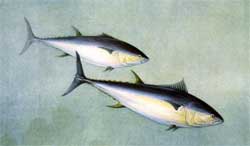|

 Speed racer: Tuna are fast swimmers (they have been measured at 77 km/h (48 mph))
and include several species that are warm-blooded. Unlike most fish
species, which have white flesh, the flesh of tuna is pink to dark
red. This is because tuna muscle tissue contains greater quantities
of myoglobin, an oxygen-binding molecule, than the muscle tissue
of most other fish species. Some of the larger tuna species such
as the bluefin tuna can raise their blood temperature above the
water temperature with muscular activity. This enables them to live
in cooler waters and survive a wider range of circumstances. Speed racer: Tuna are fast swimmers (they have been measured at 77 km/h (48 mph))
and include several species that are warm-blooded. Unlike most fish
species, which have white flesh, the flesh of tuna is pink to dark
red. This is because tuna muscle tissue contains greater quantities
of myoglobin, an oxygen-binding molecule, than the muscle tissue
of most other fish species. Some of the larger tuna species such
as the bluefin tuna can raise their blood temperature above the
water temperature with muscular activity. This enables them to live
in cooler waters and survive a wider range of circumstances.
Tuna Business: Tuna is an important commercial fish. Some varieties of tuna, such
as the bluefin and bigeye tuna are threatened by overfishing, dramatically
affecting tuna populations in the Atlantic and northwestern Pacific
Oceans. Other populations seem to support fairly healthy fisheries
(for example, the central and western Pacific skipjack tuna), but
there is mounting evidence that overcapitalization threatens tuna
fisheries world-wide.
 Increasing quantities of high-grade tuna are entering the market
from operations that rear tuna in net pens and feeding them on a
variety of bait fish. In Australia the Southern Bluefin tuna is
one of two species of bluefin tunas that is kept in tuna farms by
former fishermen. Its close relative, the Northern Bluefin Tuna,
is being used to develop tuna farming industries in the Mediterranean,
North America and Japan. Increasing quantities of high-grade tuna are entering the market
from operations that rear tuna in net pens and feeding them on a
variety of bait fish. In Australia the Southern Bluefin tuna is
one of two species of bluefin tunas that is kept in tuna farms by
former fishermen. Its close relative, the Northern Bluefin Tuna,
is being used to develop tuna farming industries in the Mediterranean,
North America and Japan.
Health Watch: Due to their high position in the food chain and the subsequent
accumulation of heavy metals from their diet, mercury levels can
be relatively high in some of the larger species of tuna such as
bluefin and albacore. As a result, in March 2004 the United States
FDA issued guidelines recommending pregnant women, nursing mothers
and children to limit their intake of tuna and other types of predatory
fish. However, most canned light tuna is skipjack tuna and is
very low in mercury.
Tuna are a common target for big-game fishing, and are mostly caught
on artificial lures.
All text is available under the terms
of the GNU Free Documentation License
|